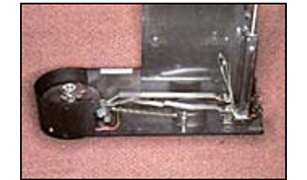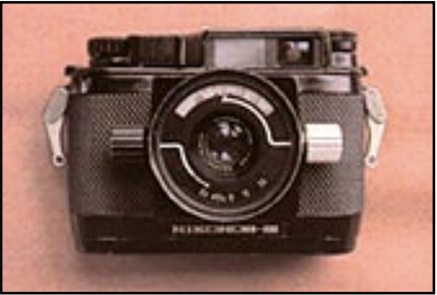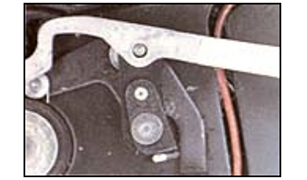

My jump school drill sergeant told me years ago that bailing out of an aircraft and falling through the air never caused a problem or messed up your body: it was only the ground coming up and the vibrations to your body from that sudden stop that you had to watch out for if your parachute didn't open. You just had to remember to hook up your static line to the aircraft, and everything else would take care of itself! Well, he was right, and nothing of mine ever got really "vibrated" (I walked away from every one)! But, I've never seen a static line on a boat to hook up my Nikonos III camera's "parachute" for those times that the camera mysteriously "bailed out" of my hands, or off of the boat's bulk head, or onto the diving platform on a choppy day.
"Vibrations? Not to my camera!" But one day you realize that the shutters no longer move when you trigger the camera. No big deal, if you have a use for a paper weight for the rest of your dive trip.
BUT, this problem can be caused by another "boo-boo" as well, so let me cover it first. You may have the style of Nikonos III which, when left in the "R" shutter speed, disengages the shutter blades from moving. So, double check to be sure you are not still in "R" from that last rewinding of the film, and that you are in an actual shutter speed setting. If you are in an actual shutter speed setting and the shutters still don't move, then the camera "ain't been gettin' them good vibrations". And, you got problems you can't fix in the field!
Top of PageVIBRATIONS! In a Nikonos III camera, the each of two shutter blades are released by their own "shutter release lever" at specified shutter-speed times. This is probably not such earth-shattering information to you since you probably already thought there had to be gears, levers, springs, screws and other stuff with weird names in your camera. But look at photo 1, and notice that the two levers are very long, like tines of a tuning fork.

Let's first talk a little about the construction and mechanics of the lower unit of a Nikonos III camera where the long shutter release levers are located. In photo 1, you will see two long silver colored levers, each terminating at the tall looped spring (behind which are located the actual shutters). And, each lever has a curved terminating end to it which is designed to hold its own shutter blade in a cocked position. On the other side of the lower unit are the gears which pull each lever away from its shutter blade. Therefore, mechanically, what we simply think of as a "shutter speed" is nothing more than the time elapsed between the camera's mechanics of releasing the first shutter blade and then releasing the second shutter blade. Well, like in anything in life, you got to get the first shutter blade to move if you want the second one to move also. Next, shutter speed timing. An easy way to understand "shutter speed" is to think of it as the elapsed time between the time at which light begins to fall upon (some point) of the film until it no longer is allowed to fall upon (some point) the film. Since the time of release of the second shutter curtain (to close the camera's "shutter" as we commonly think of it) is fixed, then the only way to engineer different shutter speeds in the camera is to cause the gears to vary the time of release (opening) of the first curtain: this variable allows for shutter speeds from "B" to 1/500 sec.
Top of Page
For each shutter speed desired, to vary the timing and achieve the desired movement (release) of the first shutter release lever requires that a variable gear hand be connected to this lever so that the gear can be positioned to release the lever at different timing sequences. To accomplish this connection, the first curtain shutter release lever (which has a small hole in it) is laid on top of a 1 mm. tall pin located at the other end of the variable gear hand (photo 2). Your "Shutter speed selection" first mechanically adjusts this variable gear hand assembly to a specified position so that during "firing of the shutters", this variable gear hand is in position to be mechanically hit (moved) by other gears in the camera, which in turn releases the first shutter curtain to "open". (Remember that the second shutter always closes at a predetermined time once the "firing of the shutters" begins.)
However, it's this need for variability of shutter speeds, and unwanted vibrations to the camera and its levers, wherein the problem lies. The first curtain's lever sits on top of this 1mm. tall pin while the second curtain's lever lays parallel to and just above it (to hold the lever onto the pin) with just enough clearance between them so that they still function independently. Therefore, strong vibrations to the camera will cause the long first curtain shutter release lever to vibrate and jump off of this pin.
Note: Just a couple of sidebar comments. This gear-to-lever coupling method had been in use for nearly 20 years before the Nikonos III came on the market. But, like the old saying, "the bigger they are, the harder they fall": remember that the Nikonos III camera is bigger and longer than its predecessors. And, no camera, even a Nikonos, was ever built to be used as a substitute for an apple if you wanted to prove the laws of gravity (and of vibration damage from that sudden stop), especially a Nikonos III.
Top of Page1. In your foam filled "traveling" camera case, never situate the camera near the outer walls of the case...house it towards the center. Prepare the foam so that the camera will be laying flat...not vertical...in the case. This way, you have given the camera maximum foam protection top-to-bottom, side-to-side.
2. If cameras are ever shipped via mail or other packaging handling companies (for purposes of buying, selling or servicing), always double box a Nikonos III: i.e., first in a small box containing its own packaging materials and the camera, then this small box inside another larger box with more packaging (vibration absorbing) materials.
3. On board boats or while simply handling a Nikonos III camera anytime, loss of control (holding) of the camera is always possible. Therefore, get yourself in the habit of reducing the distance between where you are handling the camera or the place where you set the camera while not in your hands, and the boat deck or other hard surface where the camera might fall onto. The easiest way to do this is to sit down right on the floor or deck while handling the camera, and find a place to lay the camera such that it is as close to the floor as possible just in case the boat begins to rock and throws everything around (people included). On board a boat, when I am not physically holding the camera for some reason (film changing, etc.), I leave it in a plastic trash bucket filled with plain ole' salt water, and I set bucket and all on the deck under my seat. The water acts as a baffle preventing the camera from sliding around as the boat bounces around; if the bucket should turn over, the water acts as a cushion for that moment of impact. If you have a copy of the Fall 1988 issue of Ocean Realm on Preventive Maintenance you will find out all the other reasons for using this bucket filled with salt water (like the common rinse tank is a "destruction derby" just looking for a place to happen, and other topics).
Solution: Well, if it is too late and your Nikonos III has already "bailed out" of your hands or off of a high area, you will need professional servicing along with a thread and needle for the hole in your money pocket. The whole lower unit of the camera must be removed in order to realign the gears.
If you happen to have a Style #4 Nikonos III (it has a silver colored arrow and red mark in the counter window instead of the little silver colored dot), then the vibrations mentioned above from that "sudden stop" can also cause the gears which rotate the counter wheel to vibrate out of alignment (no 1,2,3... any more). Nope, this can't be fixed in the field either: only professional assistance.
For more on this topic of different versions of the Nikonos III see:
1. Do your shutters not function when you trigger the camera? Check to first see if your shutter speed dial has been left in "R" position. If so, move it to any other shutter speed setting.
2. Shutters still not moving when the camera is triggered? Well, your Nikonos III failed to earn its "Airborne Jump Wings"? Hold on to your pocket book: it's going to be a "vibrational" shock!
3. When handling the camera (on a rocking boat, or anywhere for that matter!), think about keeping the distance your Nikonos III could fall and hit any hard surface to a minimum (try sitting on the deck, not standing?). When you ship (also meaning when "hand-carrying" aboard an airplane!), properly package your camera (foamfilled camera case: don't position the camera near an exterior wall; card board box: double box, one inside the other and each with sufficient protective packaging material on all 6 sides!)
4. What if the counter doesn't count? Do you get those mental vibrations that everything you touch mechanical sooner or later becomes damaged for some reason. Check to see if you have Style #4 camera, and check your vibrations about "vibrations."
Top of Page